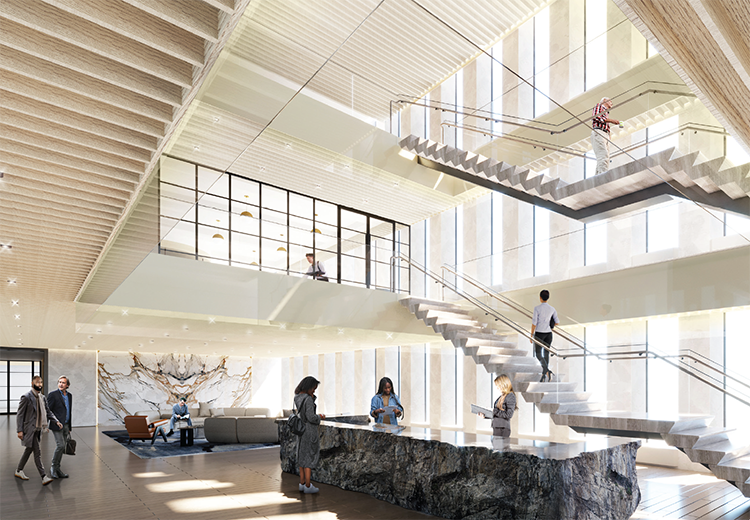Some firms expand and revamp offices to lure back remote and hybrid workers

A rendering of Lowenstein Sander's new Manhattan office lobby. (Photo courtesy of Gensler)
While Lowenstein Sandler’s attorneys and support staff were working remotely during the COVID-19 pandemic, the firm’s leaders made a bold decision: They would not only renovate their 100,000-square-foot Manhattan office but also expand it to 125,000 square feet.
“We are banking on the philosophy that if we build it, they will come,” says Joseph J. Palermo, Lowenstein’s chief operating officer. The project, scheduled to be completed in 2024, should feature more than 200 private light-filled offices with 12-foot ceilings, open collaborative spaces, high-tech conference rooms for hybrid meetings, a bistro-style café, a coffee bar, a three-story atrium and a fitness center with city views.
Palermo and firm leaders expect the revamped office to be a “destination space” for about 250 people, fostering collaboration opportunities and ad hoc mentoring. And as competition for talent accelerates, they hope those amenities will be an influential recruiting tool.
Lowenstein Sandler’s bullish approach to office space contrasts with firms that have trimmed their real estate footprint as their teams embraced remote and hybrid work. Law firms renewing their leases since the pandemic began in March 2020 have pared their square footage by at least 15%, and those that have relocated have slashed their footprints by as much as 30%, according to architecture and design firm Gensler, which is handling Lowenstein’s expansion.
Last year, Duane Morris announced plans to trim 8,000 square feet from its Pittsburgh office space, relocating to an 11,000-square-foot office. Perkins Coie has shrunk its real estate footprint by 24%, reducing office space by more than 71,000 square feet in Chicago; Denver; Palo Alto, California; and Seattle. The American Lawyer reported in April 2021 that nearly 40% of Am Law 100 firms were planning to reduce their office space.
‘Offices that are exciting’
Firms bucking that downsizing trend say they’re investing in real estate to spark collaboration and camaraderie that lawyers, associates and support staff simply can’t experience when they’re siloed in home or remote offices.
Employees at Edelson’s three offices enjoy perks including catered meals, volleyball and colorful murals in dog-friendly workspaces.
“It’s really important for us to have physical offices that are exciting to go to,” says Jay Edelson, the firm’s founder and CEO. “Our offices are our cultural center.”
The 40-lawyer firm has been in what he calls “deep-growth mode” for the past few years, and in the summer of 2021, it expanded its 4,500-square-foot San Francisco office to 7,500 square feet. It plans to double its lawyer head count in the next five years.
Edelson was initially resistant to allowing remote work because he feared firm culture, productivity and training would suffer, but he says he was proven wrong. About 40% of Edelson staff and attorneys have hybrid or remote schedules. Only those in the office at least three days a week have dedicated offices; others use a hotel-style reservation system.
Taft Stettnius & Hollister is renovating and expanding several offices to accommodate a higher head count and a demand for amenities. In the last five years, the firm’s head count has jumped from 360 lawyers to 675. The firm plans to add 8,000 square feet to its 21,000-square-foot office in Dayton, Ohio, and it expects to expand its Chicago office by 40% to more than 100,000 square feet. The project, scheduled to be completed in 2023, will include a high-tech conference center, seating to encourage collaboration and a stylish café with a plant wall.
“It really came down to reimagining the space as an investment in our people,” said Bob Hicks, Taft’s chairman and managing partner.
The relatively low cost of Midwestern real estate—$25 to $35 per square foot—makes it feasible for Taft to provide dedicated offices even for those who don’t use them daily.
“It’s not good to take away hybrid workers’ offices and expect them to want to come in,” Hicks said.
In January, Greenberg Traurig added two offices in Long Island and expanded its other metro New York offices to accommodate lawyers who live nearby, says Richard A. Rosenbaum, the firm’s executive chairman. The firm opened an office in Portland, Oregon, in February.
With fewer New York metro-area attorneys using the Manhattan office, the firm will downsize from four floors to three but invest heavily in amenities, including a state-of-the-art conference center and bright offices for nearly every attorney, plus spaces for visiting lawyers.
“We believe in people being together as much as possible,” Rosenbaum says. “You have to create an environment they want to come to.”
To attract Lowenstein’s attorneys to the Manhattan office, Gensler’s design team drew inspiration from hotel lobbies and airport lounges, which are welcoming and lively spaces that encourage contact. “Workplaces designed for human interaction will energize people,” says Gensler’s Tim Bromiley, an expert in law firm design who is overseeing Lowenstein’s project.
He and his team balanced those gathering spaces with quiet nooks and sound-muffling acoustics to foster concentration and deep thinking. Smaller offices encourage lawyers to move meetings to livelier communal spaces, and glass office walls brighten work areas and promote eye contact and connection.
Lowenstein’s Palermo is confident that the stylish design will prove irresistible.
“I’ve been here all along, and there have been some really quiet days,” he says. “But my local Starbucks has a line outside the door again. People are back in the city.”
This story was originally published in the June/July 2022 issue of the ABA Journal under the headline: “Going Big: Bucking trends, some firms expand and revamp offices to lure back remote and hybrid workers.”



